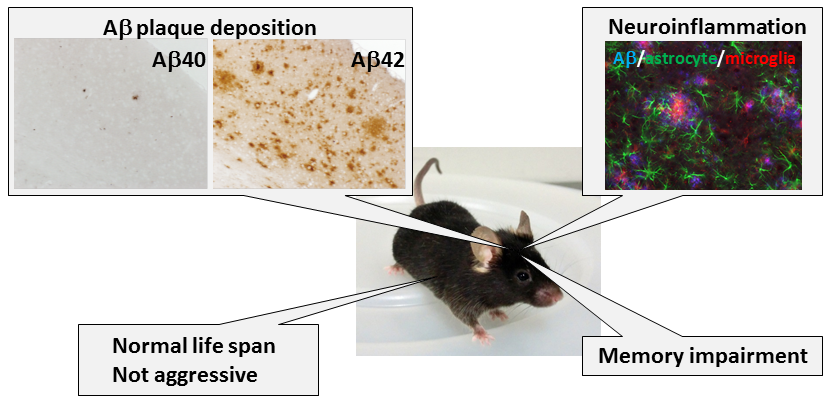|
App knock-in mouse strains: new models for C57BL/6-App<tm1(NL)Tcs>/TcsRbrc (RBRC06342)C57BL/6-App<tm2(NL-F)Tcs>/TcsRbrc (RBRC06343)C57BL/6-App<tm3(NL-G-F)Tcs>/TcsRbrc (RBRC06344)Courtesy of Takaomi C. Saido, Ph.D. and Takashi Saito, Ph.D. App knock-in mice exhibit AD patient-like Aβ42-dominant plaque deposition concomitantly with neuroinflammation and memory impairment. Importantly, the mice live normally, in contrast to previous APP overexpression-based models which are aggressive and often die of unknown cause(s). |
| Alzheimer’s disease (AD), which is the major form of dementia, is a syndrome caused by a number of progressive illnesses that affect memory and cognitive capacity. The number of people living with dementia worldwide is estimated at 44 million, and is set to almost double by 2030 if preventive therapies are not found [1]. Researchers have generated a number of transgenic (Tg) mouse models that overexpress human β amyloid (Aβ) precursor protein (APP); however, these APP-Tg mice showed artificial phenotypes that may have little to do with the human disease. |
|
Takaomi C. Saido, Takashi Saito, and colleagues at RIKEN Brain Science Institute generated App knock-in mice with the Swedish mutation (AppNL/NL, RBRC06342); Swedish and Iberian mutations (AppNL-F/NL-F, RBRC06343); and Swedish, Iberian, and Arctic mutations (AppNL-G-F/NL-G-F, RBRC06344) [2-4]. The Swedish KM670/671NL mutation increases the total amount of Aβ, while the Beyreuther/Iberian I716F mutation increases the ratio of Aβ42 to Aβ40. AppNL-F/NL-F mice, which carry the Swedish and Iberian mutations, show Aβ deposition in the cortex and hippocampus at 6 months and memory impairment at 18 months, whereas AppNL/NL mice, which carry only the Swedish mutation, are normal. The last group of generated mice, AppNL-G-F/NL-G-F, mice carry the Swedish mutation, Iberian mutation, and Arctic E693G mutation, which accelerates Aβ aggregation starting at 2 months and memory impairment at 6 months. |
|
AppNL-F/NL-F and AppNL-G-F/NL-G-F mice show typical Aβ pathology, neuroinflammation, and memory impairment, without overexpressing APP or interrupting other mouse genes. These mouse strains will stimulate further research identifying the mechanisms and pathways involved in Aβ amyloidosis. They are listed on the research models database of the web-based scientific community Alzforum [5]. |
| Depositor | : | Takaomi C. Saido, Ph.D. Laboratory for Proteolytic Neuroscience, RIKEN Brain Science Institute |
|
| Strain name | : | C57BL/6-App<tm1(NL)Tcs>/TcsRbrc | |
| RBRC No. | : | RBRC06342 | |
| Strain name | : | C57BL/6-App<tm2(NL-F)Tcs>/TcsRbrc | |
| RBRC No. | : | RBRC06343 | |
| Strain name | : | C57BL/6-App<tm3(NL-G-F)Tcs>/TcsRbrc | |
| RBRC No. | : | RBRC06344 | |
| Model to human diseases | : | ALZHEIMER DISEASE; AD OMIM ID: 104300 CEREBRAL AMYLOID ANGIOPATHY, APP-RELATED OMIM ID: 605714 |
|
| Related resources from RIKEN BRC |
: | RIKEN DNA Bank Human Resource – APP RIKEN DNA Bank Mouse Resource – App |
|
| Related resources from RIKEN BRC |
: | Disease-specific (patient-specific) iPS cells Alzheimer’s disease, familial type (iPSCs from FAD patients with mutations in presenilin 1 [A246E] and presenilin 2 [N141I]) |
|
| References | : | [1] | Alzheimer’s Disease International (ADI).World Alzheimer Report 2014: Dementia and Risk Reduction. |
| [2] | Saito T, Matsuba Y, Mihira N, Takano J, Nilsson P, Itohara S, Iwata N, Saido TC. Single App knock-in mouse models of Alzheimer’s disease. Nat Neurosci.; 17(5):661-3, 2014. | ||
| [3] | New mouse model could revolutionize research in Alzheimer’s disease. RIKEN Press Releases 2014. | ||
| [4] | New mouse models raise the bar for Alzheimer’s research. RIKEN Research 2014. | ||
| [5] | Alzforum website for webinar and information about animal models of Alzheimer’s disease: http://www.alzforum.org/. | ||
| September 2014 Contact: Shinya Ayabe, Ph.D. Experimental Animal Division, RIKEN BioResource Center All materials contained on this site may not be reproduced, distributed, displayed, published or broadcast without the prior permission of the owner of that content. |






